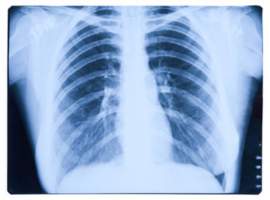
New Mesothelioma Treatment Options

Quick Summary: What is Mesothelioma Cancer? Mesothelioma is a type of cancer that forms in individuals who have a history of asbestos exposure. The disease destroys the mesothelium, which is a protective, two-layered membrane that covers several organs in the body, including the lungs, heart and abdomen. The cancer evolves from asbestos filaments. These carcinogens, when inhaled over a prolonged period of time stick to the mesothelium and eat away at its tissues. The destruction of tissues promotes proliferation; when mesothelioma metastasizes other organs are infected, rendering the disease inoperable. Asbestos, when left alone, does not pose a risk to humans; however, when the mineral is disturbed, the cancerous filaments are propelled in the area, making them susceptible to inhalation. Although mesothelioma cancer is exceptionally uncommon (roughly 3,000 new cases are diagnosed per year), those who have a prolonged history of asbestos exposure are at severe risks of contracting the deadly disease. The bulks of mesothelioma tumors develop in the lining of the lungs or the wall of the chest cavity. Common mesothelioma symptoms include: difficulty breathing, painful swallowing pleural effusion, vicious coughing, night sweats and severe or unexpected weight loss. Mesothelioma is practically impossible to detect in its early stages. Early diagnosis is exceedingly difficult because the cancer is slow-developing; symptoms do not arise until 25-50 years following the patient’s first exposure to asbestos. Moreover, the cellular makeup of mesothelioma obfuscates medical professionals with regards to diagnosing the cancer. Mesothelioma treatment options are dependent on the cancer’s stage at the time of diagnosis. The stage of mesothelioma is linked to proliferation. For example, a stage IV mesothelioma diagnosis infers metastasis to several beyond the tumors origin point. Mesothelioma life expectancy is bleak because the majority of mesothelioma cases are not detected until the disease has metastasized. Approximately 10% of mesothelioma patients are lucky enough to detect disease in its first stage. The majority of mesothelioma sufferers, therefore, are diagnosed with the cancer when it is rendered inoperable. Sufferers of advanced mesothelioma will typically live only 4 to 18 months after diagnosis. Mesothelioma may be observed in three forms: pleural, pericardial and peritoneum. Pericardium mesothelioma originates and disrupts the layer of tissues that cover the lungs; peritoneum mesothelioma disrupts the tissues that line the abdomen (known as the peritoneum; and pleural mesothelioma, which is the most frequently observed form of mesothelioma, attacks the pleura, a thin membrane of lubricating cells that surround the lungs and chest wall. The availability of mesothelioma treatment options is largely dependent on the cancer’s stage at the time of diagnosis: Stage I Mesothelioma: The earliest stage of the cancer, featuring a localized tumor, which is most often found in the lining of the lungs, the sac that protects the heart or the diaphragm. It is extremely rare to catch mesothelioma in this stage. Patients lucky enough to do so will, given a clean bill of health, be ruled eligible for curative mesothelioma treatment procedures. A curative mesothelioma surgery will extract the cancerous tumor from the body. Stage II Mesothelioma: In this stage, mesothelioma has proliferated past the point of origin. The cancer may be located in the lining of the lymph nodes or in the chest wall. Although curative surgical procedures may be an option for Stage II patients, the life expectancy has greatly decreased. Stage III Mesothelioma: It is most common for diagnosis to occur in this stage. This is an advanced form of mesothelioma that exhibits tangible symptoms. In this stage, the cancer has spread to the mediastinum, the heart, the lining of the peritoneum and beyond the diaphragm and/or the chest wall. Mesothelioma patients with stage III cancer face a grim life expectancy, because the disease has proliferated to the other side of the chest. As a result, Stage III mesothelioma sufferers may only receive palliative care to ease the symptoms associated with the disease. Palliative care is elective and is undertaken to improve the patient’s quality of life. Stage IV Mesothelioma: The final stage of mesothelioma cancer. In stage IV, the cancer has spread to distant locations in the body, making it inoperable. The cancer is very painful and only non-curable treatment options are suggested to bolster the patient’s quality of life. Life expectancy for stage IV mesothelioma patients drastically decreases to 4 to 18 months. The ability test-out cutting-edge mesothelioma treatment options is dependent on the cancer’s stage, the age/health of the patient and the location of the tumor. Although diagnosing mesothelioma is exceedingly difficult, these new mesothelioma treatment options aim to impede the cancer from spreading beyond its origin point. Moreover, new mesothelioma treatment options are attempting to revolutionize the diagnostic process, through the utilization of new imaging devices and tests. Below is a list of some of the more popular new mesothelioma treatment options. What are some New Mesothelioma Treatment Options? New treatment options to combat mesothelioma cancer are perpetually being tested. Some of the more popular and innovative mesothelioma treatment options include: Anti-Angiogenesis: This new mesothelioma treatment approach attempts to impede a tumor’s growth by synthetically cutting-off its supply to blood vessels. During the human growth process, the body requires the formation of new blood vessels to supply blood to the cells of the body; however, in a cancer patient, this process creates blood vessels to supply the tumor with nutrients and oxygen to spark growth, proliferation and the establishment of new cancer cells. A mesothelioma tumor begins as a single cell that becomes cancerous and proliferates to form multiple cancer colonies. Early on, a mesothelioma tumor utilizes nearby blood vessels to nourish itself, but as the tumor expands, it may exhaust some cells from the original blood supply. For the tumor to grow, new blood vessels must form. Anti-Angiogenesis is a new mesothelioma treatment that utilizes drugs to prevent tumors from creating new blood vessels. By impeding the tumor’s access to blood vessels, the cancer cannot grow. Researchers are currently examining both natural and synthetic anti-angiogenesis inhibitors and although the bulk of these drugs are still in clinical trials, the Food and Drug Administration approved Avastin in February 2004 for use in the treatment of colon cancer. With regards to mesothelioma treatment, a Phase II clinical trial of cisplatin and bevacizumab are ongoing. How is this Different from Chemotherapy? Anti-angiogenesis drugs do not attack cancer cells directly; rather, they target blood supplies that the tumor requires for survival and growth. By targeting the blood supply, the drugs attempt to prevent new tumors from forming and existing ones from growing. One of the primary proteins utilized to grow new blood cells is referred to a VEGF. This protein is secreted by some cancer cells and appears to play a fundamental role in the proliferation of mesothelioma cancer. VEGF adheres to proteins and forms new blood cells. The bulk of anti-angiogenesis drugs attack the pathway that creates this link. Traditional chemotherapy drugs are effective because they attack cells in the body that rapidly divide. Unfortunately, the drugs cannot differentiate between cancerous cells and normal cells, which also may rapidly divide, particularly those in the digestive system or mouth. As a result, chemotherapy yields horrible side effects including diarrhea, loss of hair, mouth sores and severe nausea. By contrast, anti-angiogenesis drugs seek blood supplies and do not target normal cells. Immunotherapy: Sometimes referred to as biological therapy, immunotherapy utilizes the body’s own immune system to shield itself against cancers. Research has shown that the immune system may be able to recognize the difference between healthy cells and cancerous ones. The ability to recognize cells triggers the most effective defense against the proliferation of cancerous bodies. Immunotherapy is therefore designed to stimulate, enhance or repair the immune system’s natural anticancer functions. Common substances applied in immunotherapy, referred to as biological response modifiers, alter the interaction between the body’s defenses and antibodies. These modifiers occur naturally in the body; however, it is now possible to synthetically produce BRMs to imitate or promote the natural immune response agents. BRM’s attempt to do the following: • Bolster the immune system’s natural response to combat cancer cell growths • Regulate, suppress or eliminate body responses that allow cancerous formations • Make cancer cells susceptible to destruction by the body’s immune system • Alter the growth patterns of cancer cells to behave like healthy cells • Impede or reverse the process that alters a normal cell into a cancerous one • Prevent cancer cells from metastasizing to other organs or bodily sites A number of BRMS are being utilized in cancer treatment, most notably interferons, tumor necrosis factor, colony-stimulating factors and cancer vaccines. Photodynamic Therapy (PDT): PDT is a new mesothelioma treatment based on the premise that single-celled organisms, when first treated with photosensitive drugs, will die when exposed to lights at specific frequencies. Using this premise, PDT aims to destroy cancerous bodies by using fixed light frequencies. The idea is that these frequencies activate photosensitizing drugs which have accumulated in body tissues. In this new mesothelioma treatment option, a photosensitizing drug is administered to concentrate in cancerous cells while quickly being eliminated from healthy ones. The targeted cancer cells are then exposed to laser lights; the cancer cells are activated by the photosensitizing drug. The laser light is delivered specifically to the cancer site through fiber optic devices that permit the laser to be controlled by the doctor. As the agent absorbs light in the targeted cells, oxygen destroys the surrounding cancerous bodies. The exposure must be precisely times so that it occurs when the bulk of the drug has left the healthy cells, but still resides in the cancerous ones. Gene Therapy: This new mesothelioma treatment option treats disease by modifying the expression of a person’s genes toward a therapeutic goal. The basic premise of this new mesothelioma treatment is based on correcting infections at the DNA level and compensating for cancerous or abnormal genes. There are two basic types of gene therapy: Replacement Gene Therapy: This new mesothelioma treatment option replaces mutated or missing genes with normal copies of that gene to keep cell growth and division under control. Knockout Gene Therapy: This form of gene therapy that targets the products of oncogenes (a gene that may induce tumor formations) as an effort to render said genes inactive. Knockout gene therapy attempts to reduce cell growth.


















